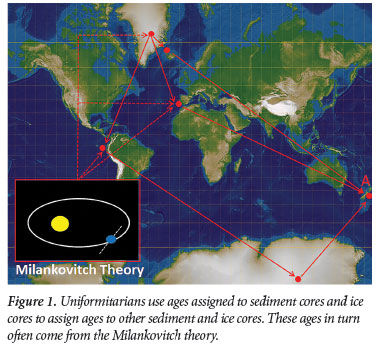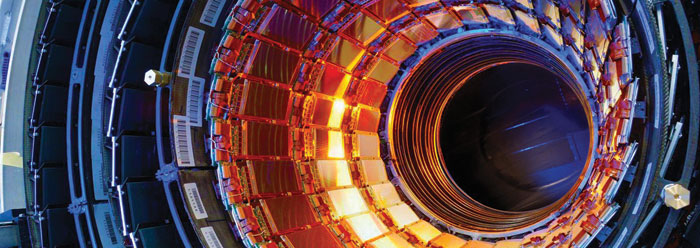Introduction
Uniformitarian scientists, who ignore the Bible’s eyewitness accounts of recent creation and the Genesis Flood, claim that dozens of ice ages have occurred over the last few million years. The Milankovitch, or astronomical, theory is their main explanation for these purported ice ages. In this view, ice ages are triggered by subtle changes in the seasonal and latitudinal distribution of sunlight. These changes in turn are caused by slow changes in Earth’s orbital and rotational motions. The Milankovitch theory is today widely accepted largely because of an important paper titled “Variations in the Earth’s Orbit: Pacemaker of the Ice Ages” that was published 40 years ago last month.1
The Pacemaker paper presented an argument based on two Indian Ocean deep-sea cores that the climate was undergoing cycles of roughly 100, 42, and 23 thousand years in length. Because these are very close to the cycle lengths that Earth’s orbital and rotational motions would exhibit in an ancient solar system, the Pacemaker paper was seen as providing strong evidence for the astronomical theory.
The Pacemaker authors used a technique called spectral analysis to confirm the astronomical theory. Geophysicist Gordon J. MacDonald and physicist Richard A. Muller wrote:
In fact, the evidence for the role of astronomy [in climate variation] comes almost exclusively from spectral analysis. The seminal paper was published in 1976, titled, “Variations of [sic] the earth’s orbit: pacemaker of the ice ages” (Hays et al., 1976).2
For this reason, the Pacemaker paper played an extremely important role in uniformitarian thinking. However, the Pacemaker paper has been invalid—even by uniformitarian reckoning—for nearly 25 years. I encourage readers who may have missed the first two articles in this series, which explain why the paper is invalid, to read them online at ICR.org.3,4
Milankovitch Theory and Dating Methods
Does other strong evidence for the theory exist? I suspect not, for reasons discussed below. But if evidence for the Milankovitch theory is weak, then the implications for uniformitarian dating methods are potentially devastating—and that’s no hype.
 Uniformitarians generally assume the astronomical theory to be correct and use it to assign ages to seafloor sediment cores through a technique called orbital tuning.5 They then use the ages assigned to the seafloor sediments to date the deep ice cores of Greenland and Antarctica, as well as other sediment cores. For instance, uniformitarian scientists used multiple ice and deep-sea cores to assign ages to one particular deep-sea core near New Zealand (the A in Figure 1). But the dates for those other cores were ultimately tied back to the Milankovitch theory.6
Uniformitarians generally assume the astronomical theory to be correct and use it to assign ages to seafloor sediment cores through a technique called orbital tuning.5 They then use the ages assigned to the seafloor sediments to date the deep ice cores of Greenland and Antarctica, as well as other sediment cores. For instance, uniformitarian scientists used multiple ice and deep-sea cores to assign ages to one particular deep-sea core near New Zealand (the A in Figure 1). But the dates for those other cores were ultimately tied back to the Milankovitch theory.6
Incredibly, uniformitarians even use the astronomical theory to calibrate the argon-argon radioisotope dating method!7
If the astronomical theory is wrong, then orbital tuning is nothing but circular reasoning, and all these age assignments are suspect—even for uniformitarians who believe in millions of years.
Milankovitch Theory and Climate Change
The astronomical theory is also contributing to climate change alarmism. Uniformitarian scientists believe the Milankovitch theory to be correct, but they also recognize that the subtle changes in sunlight caused by Earth’s orbital motions are too small, in and of themselves, to be the sole cause of an ice age. For this reason, many uniformitarian climate scientists have postulated “feedback mechanisms” to amplify these small variations in sunlight. For this reason, they have concluded that our climate is unstable. Creation researcher and atmospheric scientist Larry Vardiman noted:
A major result of this need for feedback mechanisms has been the development of a perspective that the earth’s climate system is extremely sensitive to minor disturbances. A relatively minor perturbation could initiate a non-linear response which might lead to another “Ice Age” or “Greenhouse.” Because of the fear that a small perturbation might lead to serious consequences, radical environmental policies on the release of smoke, chemicals, and other pollutants and the cutting of trees have been imposed by international agencies and some countries. If the basis for the Astronomical Theory is wrong, many of the more radical environmental efforts may be unjustified.8
The Milankovitch theory is also contributing to concern over future rising of sea levels. Respected uniformitarian oceanographer Wolfgang Berger asked the question:
Just when can we expect to see a rapid rise of sea level, ten times higher than the present values of a few millimeters per year? We do not know. All we can say, from experience with the many millennia of the ice-age records in the deep sea, is that once melting starts, it stimulates further melting for centuries. Deglaciation keeps going once begun in earnest: a great example of the dilemma of the sorcerer’s apprentice.9
What Berger is calling “experience” is really just a Milankovitch interpretation of the seafloor sediment data. But if the Milankovitch theory is wrong, then this argument for rapid sea level rise is invalid. This is a good example of how wrong ideas about our origins can have serious negative consequences in the present.
The Age Revision That Caused All the Trouble
The original Pacemaker paper used age estimates from a 1973 paper by Nicholas Shackleton and Neil Opdyke.10 This 1973 paper assumed that the Brunhes-Matuyama (B-M) magnetic reversal, the most recent reversal of Earth’s magnetic field, occurred 700,000 years (700 ka) ago. The date for the reversal was obtained from the potassium-argon (K-Ar) radioisotope dating method. However, in 1979, uniformitarians revised the age of the B-M reversal boundary upward to 730 ka, based on new data and revised values of the K-Ar dating constants.11
In 1990, Nicholas Shackleton and others, after orbitally tuning chemical wiggles within a Galápagos deep-sea core, recommended that the age of the B-M reversal be increased to 780,000 years.12 Another scientist, F. J. Hilgen, after attempting to orbitally tune features within a number of Mediterranean cores, made a similar recommendation.13 Therefore, the radioisotope dates were overruled and the age of the B-M reversal became 780 ka. Although this revised date was soon “confirmed” by radioisotope dating, there appears to have been little, if any, real justification for this higher age estimate at the time.14
The Dates Don’t All Agree
Uniformitarians were more than happy to use an age of 700 ka for the B-M reversal boundary, along with chemical wiggles from two Indian Ocean cores, to convince the world that the Milankovitch theory was correct. But they were unable to orbitally tune wiggles within other sediment cores unless they changed the age of the B-M reversal to 780 ka.
This is ridiculous. The B-M reversal boundary can only have one true age—not two! If uniformitarian scientists really believe that the correct age for the reversal is 780 ka, then logically they should have gone back and redone the Pacemaker analysis, as I did, taking this new age estimate into account.
Other Evidence for the Theory?
Milankovitch proponents might argue there is still strong evidence for the theory apart from the Pacemaker results. After all, many, many scientific papers dealing with the astronomical theory have been published. This is true, but most of these papers simply assume the theory is true and then attempt to draw conclusions from that assumption. There are at least four reasons to suspect that additional hard evidence for the theory is weak at best.
First, confirming the astronomical theory, even if it were correct, is not easy. One needs long, undisturbed sediment cores with the right properties for such an analysis, and such cores are not necessarily numerous. The Pacemaker authors claimed that, at the time, only two such deep-sea cores, out of several hundred, had the right properties for such an analysis.1
Second, Wolfgang Berger made an eye-opening observation regarding what he considers to be the “strongest argument yet” for the Milankovitch theory:
In the end, the correct timescale [for the marine sediment cores] was a matter of co-ordinating isotope stratigraphy with the results from palaeomagnetism, applying the date found in basalt layers for the Matuyama-Brunhes boundary to cores with known magnetic stratigraphy (as in Shackleton & Opdyke 1973). The agreement of dating by that method and by Milankovitch tuning (urged by Shackleton et al. 1990) is the strongest argument yet for the correctness of Milankovitch theory.15
As already noted, the Pacemaker authors used the results from the 1973 Shackleton and Opdyke paper to help construct the timescales for the two sediment cores in their analysis. But Shackleton and Opdyke assumed an age of 700 ka for the B-M reversal boundary. The 1990 paper by Shackleton et al. is the paper that recommended revising the age of the B-M reversal to 780 ka. Those two papers require two completely different ages for the B-M reversal boundary.16 If the “strongest argument yet” for the Milankovitch theory requires the most recent reversal of the Earth’s magnetic field to have two different ages, then it is safe to say that the theory is in serious trouble.
This is itself a third reason to suspect that evidence for the theory is weak. If one needs to arbitrarily use different ages for the same magnetic reversal to reconcile all the data with the theory (in other words, “fudging”), why should anyone take the theory seriously?
Fourth, the original Pacemaker results imply a “linear” climate response, at least for the 41,000 and 23,000-year astronomical cycles.1 This means that the output frequencies of the climate response are equal to the input frequencies of the astronomical cycles.17 However, one could also assume that the climate responds in a “nonlinear” way so that the frequencies of the climate cycles are different from those of the orbital cycles. In fact, some uniformitarian scientists have argued for nonlinear versions of the astronomical theory.18,19 Obviously, they are having difficulty getting all the data to fit a single version of the theory and the details of the theory have not yet been nailed down. But how is one supposed to test a theory whose details are still “fuzzy”?
Conclusion
The “Pacemaker of the Ice Ages” paper has long been an iconic argument for the Milankovitch theory. Furthermore, because the astronomical theory assumes millions of years of Earth history, this well-known paper has also long been seen as supporting an old earth. However, it has been invalid for a quarter century, and other possible evidence for the astronomical theory seems weak at best. Therefore, Christians who believe the Bible’s depiction of a recent creation and a young earth should be encouraged by these results, as they are very damaging to uniformitarian dating methods. Likewise, the results give us yet another reason to question the current alarmism over the issue of climate change.
Click here to read “Milankovitch Meltdown: Toppling an Iconic Old-Earth Argument, Part 1.”
Click here to read “Milankovitch Meltdown: Toppling an Iconic Old-Earth Argument, Part 2.”
References
- Hays, J. D., J. Imbrie, and N. J. Shackleton. 1976. Variations in the Earth’s Orbit: Pacemaker of the Ice Ages. Science. 194 (4270): 1121-1132.
- Muller, R. A. and G. J. MacDonald. 2000. Ice Ages and Astronomical Causes: Data, Spectral Analysis and Mechanisms. Chichester, UK: Praxis Publishing, xiv.
- Hebert, J. 2016. Milankovitch Meltdown, Part 1. Acts & Facts. 45 (11): 10-13.
- Hebert, J. 2016. Milankovitch Meltdown, Part 2. Acts & Facts. 45 (12): 10-13.
- Hebert, J. 2014. Ice Cores, Seafloor Sediments, and the Age of the Earth, Part 1. Acts & Facts. 43 (6): 12-14.
- Hebert, J. 2016. Deep Core Dating and Circular Reasoning. Acts & Facts. 45 (3): 9-11.
- Renne, P. R. et al. 1994. Intercalibration of astronomical and radioisotope time. Geology. 22 (9): 783-786.
- Vardiman, L. 2001. Climates Before and After the Genesis Flood. El Cajon, CA: Institute for Creation Research, 79.
- Berger, W. H. 2012. Milankovitch Theory – Hits and Misses. Scripps Institution of Oceanography, University of California San Diego, Technical Report, 16. Emphasis added.
- Shackleton, N. J. and N. D. Opdyke. 1973. Oxygen Isotope and Palaeomagnetic Stratigraphy of Equatorial Pacific Core V28-238: Oxygen Isotope Temperatures and Ice Volumes on a 105 Year and 106 Year Scale. Quaternary Research. 3 (1): 39-55.
- Mankinen, E. A. and G. B. Dalrymple. 1979. Revised Geomagnetic Polarity Time Scale for the Interval 0-5 m.y. B.P. Journal of Geophysical Research: Solid Earth. 84 (B2): 615- 626.
- Shackleton, N. J., A. Berger, and W. R. Peltier. 1990. An Alternative Astronomical Calibration of the Lower Pleistocene Timescale Based on ODP Site 677. Transactions of the Royal Society of Edinburgh: Earth Sciences. 81 (4): 251-261.
- Hilgen, F. J. 1991. Astronomical calibration of Gauss to Matuyama saproprels in the Mediterranean and implication for the Geomagnetic Polarity Time Scale. Earth and Planetary Science Letters. 104 (2-4): 226-244.
- Spell, T. L. and I. McDougall. 1992. Revisions to the age of the Brunhes-Matuyama Boundary and the Pleistocene geomagnetic polarity timescale. Geophysical Research Letters. 19 (12): 1181-1184.
- Berger, W. H. 2014. On the Beginnings of Palaeoceanography: Foraminifera, Pioneers, and the Albatross Expedition. In Landmarks in Foraminiferal Micropalaeontology: History and Development. A. J. Bowden, F. J. Gregory, and A. S. Henderson, eds. London: Geological Society Publishing House: 169. Emphasis added.
- Published uncertainties in radioisotope ages for the B-M reversal boundary are roughly 10 ka—much too small to account for the apparent 80,000-year age difference.
- Note that the frequency of a cycle is just the reciprocal of the length, or period: frequency = 1 ÷ period.
- Rial, J. A. and C. A. Anaclerio. 2000. Understanding nonlinear responses of the climate system to orbital forcing. Quaternary Science Reviews. 19 (17-18): 1709-1722.
- Lourens. L. J. et al. 2010. Linear and non-linear response of late Neogene glacial cycles to obliquity forcing and implications for the Milankovitch theory. Quaternary Science Reviews. 29 (1-2): 352-365.
* Dr. Hebert is Research Associate at the Institute for Creation Research and earned his Ph.D. in physics from the University of Texas at Dallas.





















